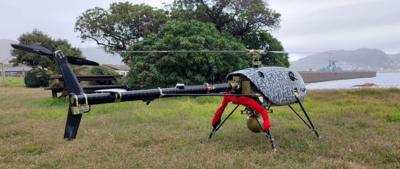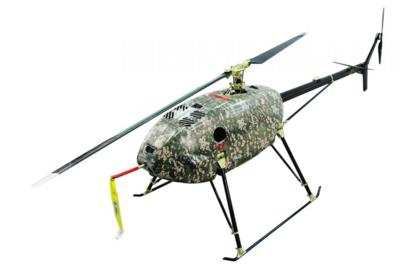Sun, Apr 21, 2024
UAVOS Debuts UVH 170 Unmanned Wildfire Fighting Helo
UAVOS has recently achieved a significant milestone in public safety and emergency services with the first operational deployment of its UVH 170 unmanned helicopter, designed specifically for wildfire suppression.

The deployment, which involved both day and night operations, represents a critical advancement in the use of unmanned aerial vehicles (UAVs) in managing natural disasters.
The UVH 170 is equipped with state-of-the-art technology, including the Gimbal 201, which allows for high-precision georeferenced data acquisition through visible-light and thermal imaging cameras. This technology meets the stringent requirements of fire services for target sensitivity, accuracy, and timely data delivery, which are crucial for effective fire management and containment strategies.
During its inaugural field mission, the UAVOS UVH 170 demonstrated its capability to operate autonomously for up to five hours and handle payloads up to 4 kilograms. Such capacity is essential for carrying sophisticated sensors used in both civilian and security applications.

By flying at altitudes of two thousand meters above the ground, the UAV can capture detailed video feeds of the fire's boundaries. These feeds are georeferenced in real-time and streamed back to the UAS ground control station, providing immediate situational awareness to firefighting teams on the ground.
This real-time data transfer is pivotal in eliminating delays often associated with traditional methods of imagery acquisition, interpretation, transmission, and production. Consequently, fire management personnel are equipped with up-to-the-minute updates that enable them to make informed decisions quickly and efficiently. The speed of data processing and delivery enhances the overall responsiveness of firefighting efforts, allowing teams to adapt to changing conditions and effectively allocate resources where they are most needed.
Aliaksei Stratsilatau, CEO of UAVOS, emphasized the operational benefits of the UVH 170, noting that "operating from a safe distance, a drone pilot can identify and geo-locate hot spots providing critical information to the fire management team to aid them with planning, resource management, and assigning tasks and priorities for the day."
The successful deployment of the UVH 170 underscores the growing role of UAV technology in enhancing public safety and emergency response strategies. UAVOS's advancements in UAV technology represent a transformative shift in how emergency services tackle the challenges posed by natural disasters, particularly in the realm of wildfire management.
More News
Performance-Based Navigation (PBN) [ICAO] Area navigation based on performance requirements for aircraft operating along an ATS route, on an instrument approach procedure or in a d>[...]
The Airplane Came To Rest Underneath A Set Of Damaged Power Distribution Lines On The Floor Of A Coulee On June 19, 2025, at 1412 mountain daylight time, a Cessna 172K airplane, N7>[...]
Aero Linx: FAA Managers Association (FAAMA) Recognized by the FAA, FAAMA is a professional association dedicated to the promotion of excellence in public service. The Association i>[...]
From 2023 (YouTube Edition): Jet Central Micro-Turbine Engines Impress Founded in the late-1990s, Mexico City-based Jet Central produces a unique and fascinating line of micro-turb>[...]
Also: ANOTHER Illegal Drone, KidVenture Educational Activities, Record Launches, TSA v Shoes The Senate confirmed Bryan Bedford to become the next Administrator of the FAA, in a ne>[...]
 ANN's Daily Aero-Term (07.10.25): Performance-Based Navigation (PBN) [ICAO]
ANN's Daily Aero-Term (07.10.25): Performance-Based Navigation (PBN) [ICAO] NTSB Prelim: Cessna 172
NTSB Prelim: Cessna 172 ANN's Daily Aero-Linx (07.10.25)
ANN's Daily Aero-Linx (07.10.25) Classic Aero-TV: The Big Business of Diminutive Powerplants
Classic Aero-TV: The Big Business of Diminutive Powerplants Airborne 07.11.25: New FAA Bos, New NASA Boss (Kinda), WB57s Over TX
Airborne 07.11.25: New FAA Bos, New NASA Boss (Kinda), WB57s Over TX




